Waldorf News
Mandala: The Encircling Round Holds Sway
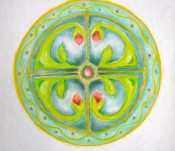
By VAN JAMES
“The eye is the first circle; the horizon which it forms is the second; and throughout nature this primary figure is repeated without end. It is the highest emblem in the cipher of the world…We are all our lifetime reading the copious sense of this first of forms.”—Ralph Waldo Emerson
The mandala is generally thought of as an eastern tradition, a motif of Hindu and Buddhist ritual iconography. The Tibetan Buddhist practice of constructing intricate sand mandalas is now fairly well known in the West due to regular demonstrations and exhibitions at art museums, civic centers, and churches throughout Europe and America.
However, the mandala, which means circle (manda = cream, best part, highest point; la = sign post, indication, completion) in Sanskrit, or essence container in Tibetan, is just as much a western and modern tradition as it is an eastern and ancient one. In fact the mandala or circle is one of the oldest, most wide spread and most continuously used images in art. Primal peoples have always seen the circle (mandala) as the image of wholeness, completeness, perfection, unity, nature, Goddess, or God (fig. 1). Maria Gimbutas states in regard to the carved circular petroglyph images found throughout the world: “These are the symbols of the center, the source or focal point where life begins and flows out, increasing in concentric circles and arcs. If it were possible to count all cupmarks (artificial and natural), circles (concentric and open), and dot-in-circle motifs, it would become clear that these symbols are the most numerous of all, and therefore germinal.”1
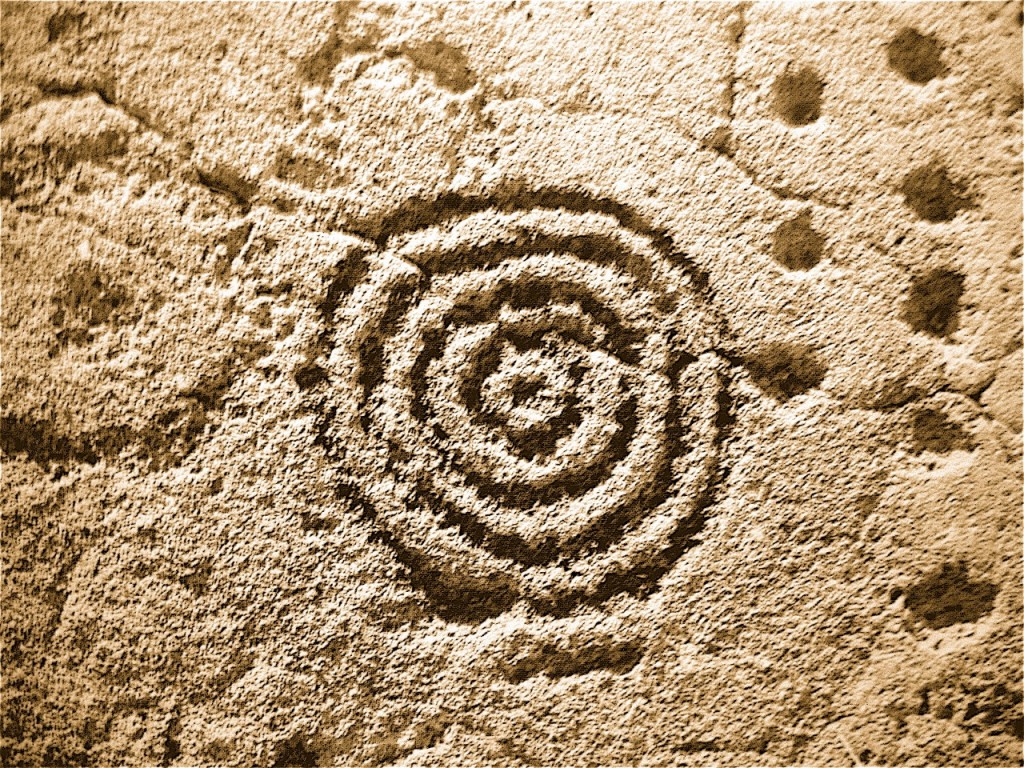
Fig. 1. Circular forms are the oldest, most wide spread and most continuously produced images in art. These cupmark and circle petrogyphs, carved in lava rock surfaces in the Hawaiian Islands, were used as recepticles for receiving the umbilical cord stumps of newborn infants and there to absorb the mana or spiritual power of the cosmos for the sake of the child.
Christian Mandalas
The large circular windows of Christian cathedrals can be seen as colorful stained glass mandalas (fig. 2). Usually divided into sections representing the twelve zodiacal positions of the heavens, the twelve apostles, or the tribes of Israel, they also have a further four-fold division into the cardinal directions or the fixed points of the zodiac and the four gospels. The placement of divine beings, angelic figures, and saintly personages at crucial positions within the mandala-windows establishes the powerful storyline of the Christian world conception and is similar to the positioning of the numerous deities in eastern mandalas.
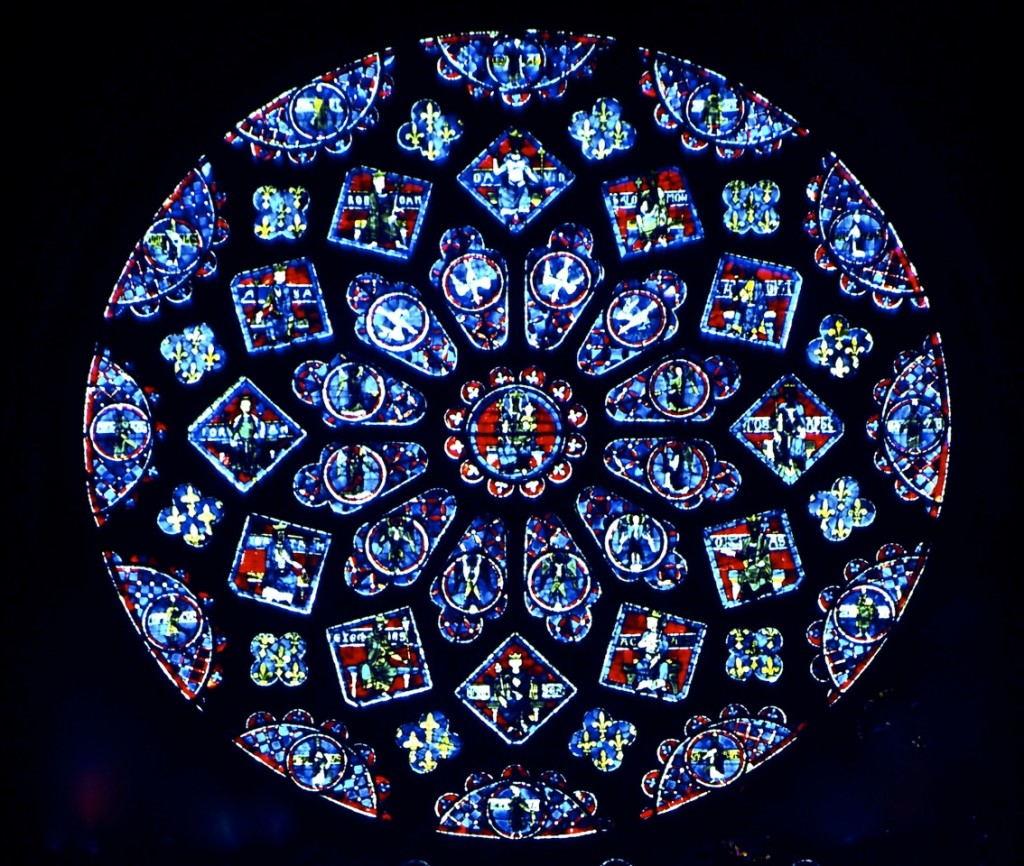 Fig. 2. The stained glass windows of Christian cathedrals are in effect large, colorful mandalas. The placement of divine beings, angelic figures, and holy personages at crucial positions within the circular windows establishes the powerful storyline of the Christian legends. Here is a portion of the Rose Window from Chartres Cathedral in France.
Fig. 2. The stained glass windows of Christian cathedrals are in effect large, colorful mandalas. The placement of divine beings, angelic figures, and holy personages at crucial positions within the circular windows establishes the powerful storyline of the Christian legends. Here is a portion of the Rose Window from Chartres Cathedral in France.
The circular domes of religious buildings are powerful spatial influences intended to accompany the faithful from birth (baptistries) through life (churches and cathedrals) to death (mausoleums). The dome is a three-dimensional, architectonic mandala, and its use in Christian, Hebrew, and Islamic holy places and later secular structures is widespread for its restful, calming effect.
The tondo or circular canvas was also a device used by Renaissance painters to express wholeness and to impress upon one’s emotions the feeling of peacefulness. Madonna and child pictures often used this format.
Within the Christian esoteric tradition and in Rosicrucian brotherhoods the mandala was frequently used as a device for expressing the hermetic mysteries and secret workings of the world. Alchemical manuscript illuminations abound with pictures of the various kingdoms of nature and levels of natural and heavenly orders articulating creation, all within the circular format of the mandala. The work of Hildegard von Bingen (fig. 3), Jacob Boehme, Robert Fludd, and many others demonstrate the mandala tradition in European art and spirituality. Such imagery included the biblical seven seals of the Apocalypse, images drawn directly from the Bible, from the Book of Revelation by Saint John.
 Fig. 3 (left). Hildegard von Bingen, an 11th century Benedictine abbess, painter, playwrite and musician, created numerous Christian mandalas based on her visionary experiences. Liber divinorum operum.
Fig. 3 (left). Hildegard von Bingen, an 11th century Benedictine abbess, painter, playwrite and musician, created numerous Christian mandalas based on her visionary experiences. Liber divinorum operum.
Modern Mandalas
In 1907 Rudolf Steiner created mandala pictures of the seven apocalyptic seals as well as completely original linear patterns drawn in connection with a sevenfold planetary system. These latter mandala forms were related to one another by way of metamorphosis (fig. 4). That is each form relates to the one before and after it like a seed, sprout, stem, leaf, bud, blossom, and fruit are all related yet completely different in form from each other. These circular designs, conceived in a seven-part rotational pattern, were directly related to the development of the capital forms and architectural design of Steiner’s first Goetheanum building (1913-1922). Of these forms, Steiner said: “It is not intended here that the forms…should be grasped intellectually, but that they are to be experienced artistically through the feelings, in imagination. For every line, every curve, indeed the whole being of these forms is such that, by submerging oneself in them, forces slumbering in one’s soul can be awakened, and these forces lead to concepts of the great mysteries of the world which lie at the foundation of the cosmic evolution of the earth and humanity.”2 This is noless than a description of the mandala principle.
Steiner’s description of how one may enter into these planetary seal forms and what one can receive from them is in exact accord with the practices of the mandala tradition. Meditate on the forms and inner experiences are awakened. Steiner regenerates the possibility of a modern, western mandala practice, although he refers to these forms as seals–never using the Sanskrit term, mandala—thereby stressing a western character to them. Steiner created other seal (mandala) forms and many of his lectures included blackboard drawings with simple point and periphery (mandala) diagrams stressing how the point is a microcosmic circle and a circle is a macrocosmic point.
A few years after Rudolf Steiner designed his seal-mandalas and not far away in another part of Switzerland, Carl Jung began experimenting with mandalas, at first privately for himself, and later with patients in his psychiatric practice. During the First World War and out of a personal crisis, Jung, one of the founders of analytical psychology, noticed that the mandala sketches he did captured something of the soul quality or inner character of the moment in which they were executed. He also noticed that whatever images were placed within the circle were already brought closer to a harmony by means of this special form enclosing them. “The fact that images of this kind [mandalas] have under certain circumstances a considerable therapeutic effect on their authors is empirically proved and also readily understandable, in that they often represent very bold attempts to see and put together apparently irreconcilable opposites and bridge over apparently hopeless splits. Even the mere attempt in this direction usually has a healing effect.”3
Jung worked with mandalas for many years before making his research known. He suggested that images appearing in the upper part of the mandala relate to the conscious mind and images appearing in the lower part are an expression of what he called the collective unconscious. According to his ideas, imagery to the left and right can have masculine (animus) or feminine (anima) connotations, while whatever is placed in the immediate center has the greatest thematic significance in the moment for the person creating the mandala. Today there are art therapy practices that utilize this Jungian approach in diagnostic mandala work. Jung recognized the importance of doing mandalas and said: “In accord with the Eastern conception, the mandala symbol is not only a means of expression, but works an effect. It reacts upon its maker. Very ancient magical effects lie hidden in this symbol…the magic of which has been preserved in countless folk customs.”4
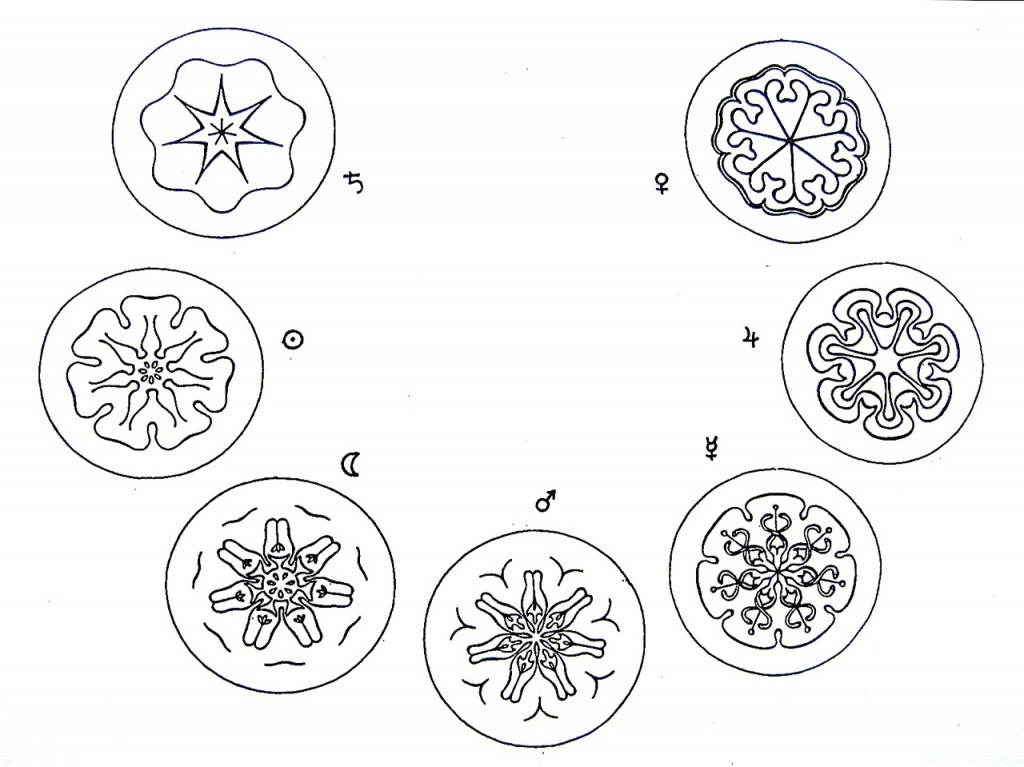
Fig. 4. Rudolf Steiner’s seven Planetary Seals, conceived in a seven-part rotational pattern, may if “…submerging oneself in them,” awaken slumbering forces in one’s soul, “and these forces lead to concepts of the great mysteries of the world which lie at the foundation of the cosmic evolution of the earth and humanity.”
Contemporary Mandalas
Although the mandala originates and continues to thrive in the context of the sacred, its special status can nevertheless be usurped for the purposes of the secular and the profane. Consumer studies show that shoppers have a preference for items that incorporate the circle– in fact we purchase items with circles on them 40% more often than those with any other shape. Consider the large number of consumer products and corporate logos that incorporate the circle in their design: Coke, Pepsi, Burger King, Tide, Quaker Oats, 76, Circle K, Mercedes Benz, and Target to mention just a few. Knowledge of the circle’s power is effectively put to use by many advertisers today for the purpose of manipulating the consumer’s unconscious sense for form.
On the other hand, if one examines the evolution of children’s drawings one sees that a striving to articulate an experience of the self (microcosm) within the world (macrocosm) is taking place. The alphabet of form–curved and straight lines– utilized by the child to create a mandala is essentially the recognition of the human being as an image of universal forces and a self-portrait at the same time. From the circular form of the head to the extensions of trunk and limbs children acknowledge and document their own process of incarnation into their bodies and on to the earth (fig. 5). This striving toward the realization of ones own humanity, ones own self is a basic feature and ever-present spiritual capacity in all healthy human beings. It is also the principle impulse behind the artistic rendering of mandalas.
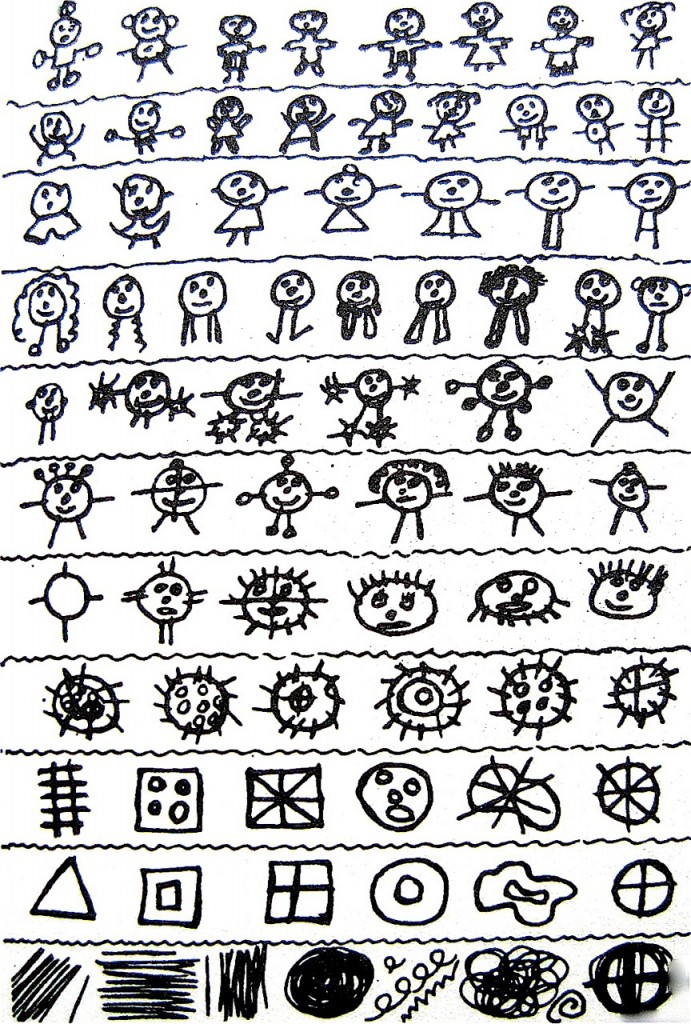
Fig. 5. From the circular form of the head to the extensions of trunk and limbs children acknowledge and document their own process of incarnation into their bodies and on to the earth. (Illustration after Sally Fincher)
Mandala design and construction can include study of traditional art, work with symmetry, pattern, metamorphosis, signs and symbols, color, dream imagery, festival and curriculum themes. Working with the various divisions of the circle and freehand geometry is most helpful in this regard and it encourages our innate sense for form to become more conscious to us. The art of mandalas is a picturing and a self-portraying of the universal human being toward an individual entity. This is why it is so effective for work with children, young people and adults of all ages (fig. 6). It is an ordering of elements and a shaping of awareness toward the end of creating a sacred space, a consecrated place in which the self can experience itself as an image of the world and the world can live in a picture of the self. The history of the mandala is an ever-transforming search for a true portrait of the universal Self.
“The mandala and its symbols are the windows through which we can view the essential nature of our being.” —Ngakpa Chogyam
Notes:
1. Gimbutas, M. Civilization of the Goddess, p. 304.
2. Steiner, R. Lucifer-Gnosis, Nr. 43. GA 284/285.
3. Jung, C.J. Mandala Symbolism, p.
4. Jung, C.J. Archetypes and the Collective Unconscious, p.352-53.
This article is abridged from the book The Secret Language of Form: Visual Meaning in Art and Nature, by Van James. (Rudolf Steiner College Press in 2007)
The art of the mandala is a picturing and a self-portraying of the universal human being toward an individual entity. This is why it is so effective for work with children, young people and adults of all ages. Here are some mandala examples by high school students:












 ~ Ensoul Your World With Color ~
~ Ensoul Your World With Color ~ The Art of Administration and Leadership
The Art of Administration and Leadership Waldorf-inspired Homeschool Curriculum
Waldorf-inspired Homeschool Curriculum Roadmap to Literacy Books & Courses
Roadmap to Literacy Books & Courses Quality Education in the Heartland
Quality Education in the Heartland Jamie York Books, Resources, Workshops
Jamie York Books, Resources, Workshops Middle School Science With Roberto Trostli
Middle School Science With Roberto Trostli Association for a Healing Education
Association for a Healing Education Bay Area Teacher Training
Bay Area Teacher Training Waldorf EC Training & Intensives in Canada
Waldorf EC Training & Intensives in Canada The Journey is Everything
The Journey is Everything Discovering the Wisdom of Childhood
Discovering the Wisdom of Childhood Everything a Teacher Needs
Everything a Teacher Needs Apply Today: New Cohort Starts Nov. 2025
Apply Today: New Cohort Starts Nov. 2025 Bringing Love to Learning for a Lifetime
Bringing Love to Learning for a Lifetime Art of Teaching Summer Courses 2025
Art of Teaching Summer Courses 2025 Caring for All Stages of Life
Caring for All Stages of Life Grade Level Training in Southern California
Grade Level Training in Southern California Transforming Voices Worldwide
Transforming Voices Worldwide Flexible preparation for your new grade
Flexible preparation for your new grade Immersive Academics and Arts
Immersive Academics and Arts Full-Time Teacher Education
Full-Time Teacher Education Train to Teach in Seattle
Train to Teach in Seattle Storytelling Skills for Teachers
Storytelling Skills for Teachers Summer Programs - Culminating Class Trips
Summer Programs - Culminating Class Trips Space speaks. Its language is movement.
Space speaks. Its language is movement. Dancing for All Ages
Dancing for All Ages RSS Feeds
RSS Feeds